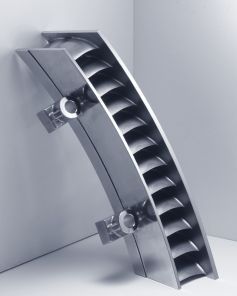3D printing moves into shopfloor at MAN Diesel & Turbo
MAN Diesel & Turbo is now equipping gas turbines with 3D-printed components. CEO Uwe Lauber said the company is not only using complex 3D-printed metallic components for test runs but also for serial production.

3D-printed guide vane segment for a MAN Diesel & Turbo gas turbine[/caption]
Roland Herzog, Head of Material Technology in the Strategic Business Unit Turbomachinery: “Additive manufacturing offers huge potential for our product range, especially when it comes to the production of gas turbine components. Additively manufactured guide vane segments that we are now incorporating into our type MGT6100 gas turbines have proven particularly suitable. The approval for serial production is the result of intense cooperation with highly specialized suppliers and development partners such as the Fraunhofer Institute for Laser Technology,” explains Herzog. In order to exploit the potential of the technology even further, MAN Diesel & Turbo is currently investing in the “MAN Center for Additive Manufacturing,” a product and location-independent expert centre based at the company’s turbomachinery works in Oberhausen.
Design specialists, materials experts and production engineers come together at “MANCAM” to extend the benefits of additive manufacturing to further components and products, for example compressor impellers or fuel nozzles for engines. Herzog adds: “We are currently investing some EUR 2.6 million in order to utilise the numerous benefits of additive manufacturing along the whole value chain. As well as shortened development cycles, 3D printing gives more freedom for innovative, superior component designs, reduces production and delivery times and enables us service-wise to produce spare parts on call.” Lauber, who is both CEO and Chief Technology Officer, explains: “The standardized use of additive manufacturing is a strategic milestone for MAN Diesel & Turbo. 3D printing gives us clear competitive advantages in terms of our products supporting the decarbonization of industry and power generation.
The techniques considerably reduce the path from an innovative design to a finished product. The digital data from our R&D departments can be converted into better products more quickly than before, while customers are supported throughout the entire product lifecycle with 3D-printing-based services.”
Additive manufacturing, also known as 3D printing, covers a range of innovative production processes, the potential of which is currently being investigated and developed in various industries, including machine and vehicle manufacturing, the aerospace industry and medical technology.
As well as plastic materials, there are now also processes which enable 3D printing based on metallic materials. Examples include Selective Laser Melting (SLM) and Electron Beam Melting (EBM). Depending on factors such as lot sizes and material costs, these open up numerous benefits over conventional production processes along the whole value chain of a product – from development and production through to maintenance and service.